What Vegetables Need a Trellis? 12 Common Types
-
Pete Ortiz
- Last updated:
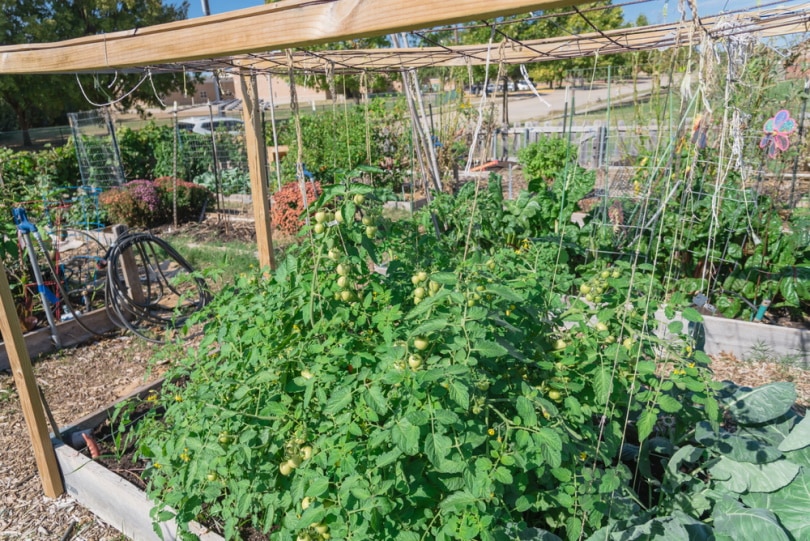
Growing vegetables in your garden can be lots of fun. However, if most of your veggies are vining plants, it will take a lot of work to take care of the crops and ensure steady growth. That’s when trellises come in. Specifically built for one reason—to help crops climb up (vertically), they make running a successful vegetable garden dramatically easier.
But wait, is a trellis necessary for all vegetables out there? How do you know which plants do, indeed, need it? We’ve got your back! The following list includes 12 veggies that will greatly benefit from growing on a trellis. We’ve got tomatoes, cucumbers, watermelons, beans, and more. Check them out!
Why Grow Veggies on a Trellis?
If you have a relatively small garden, a trellis will help you make the best of it. When used properly, you will get a lot more produce because of the extra space, sun, and better air circulation. Second, when vegetables grow vertically, that makes it harder for pests and diseases to infect them. Still not sure if you need a trellis? Then just know that harvesting is much easier with everything within reach.
This is especially true if you have back pains or just don’t like to bend over to pick every single vegetable. And finally, you won’t have to do any cleaning. It is no secret that veggies get dirty while growing on the ground. So, these are our four main reasons why a trellis will be a welcome guest if you have one of the following veggies:
The 12 Common Types of Vegetable to Grow On a Trellis
1. Vining Cucumbers
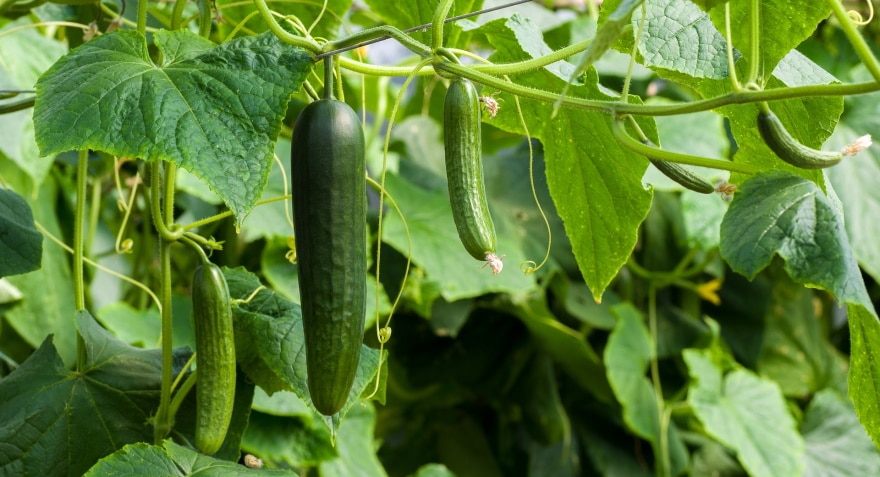
| Botanical Name | Cucumis sativus |
| Soil | Well-drained, sandy, loamy, rich (pH 6.0–6.5) |
| Sun | Full sunlight |
| Hardiness zone | 8–12 |
| Days to harvest | 50–70 days from planting |
| Average vine length | 5–8 feet |
Cucumbers are one of the easiest plants to grow on a trellis. The vines are quite short (8 feet max), which is why A-frame trellises are the way to go here. Cucumbers are prolific growers, meaning one single plant produces lots of vegetables. As long as the soil is rich in nutrients and well-drained, they will grow and prosper. You will have to ensure 6–8 hours of sun during the day, though, and thorough watering.
Before you plant anything, make sure you have the right seeds! We are talking about vining vs. bush cucumbers. You can go with slicing, pickling, or novelty varieties. Saw the seeds in mid-spring and then once again in late summer. Cucumbers can be quite heavy; make sure the trellis can handle all that weight!
2. Luffa/Loofah

| Botanical Name | Luffa aegyptiaca |
| Soil | Well-drained, moist, enriched (pH 6.0–6.5) |
| Sun | Full sunlight |
| Hardiness Zone | 7–11 |
| Days to harvest | 90–120 days from planting |
| Average vine length | 20–30 feet |
Luffas are even heavier than cucumbers. So, the trellis should be brick-strong. The vines are rather long (up to 30 feet) and tend to “get off course”. So, pay extra attention to that and do some gentle re-routing. Also, give them enough space to “maneuver”. Luffas don’t need much help growing on a trellis.
They are big fans of full exposure to the sun, though, and flourish in moist, enriched, and well-drained soil. When grown vertically, these vegetables avoid discoloration and rot.
3. Tomatoes

| Botanical Name | Solanum lycopersicum |
| Soil | Well-drained, fertile, loamy (pH 5.8–7.0) |
| Sun | Full sunlight |
| Hardiness Zone | 5–11 |
| Days to harvest | 50–120 days from planting |
| Average vine length | 6–12 feet |
Indeterminate tomatoes are perfect for growing on a trellis. Instead of one harvest, you’ll get a constant inflow of delicious veggies. See that the tomatoes get enough sunlight and that the soil is loamy and fertile. The vines won’t cause any issues, as they don’t grow longer than 12 feet. Black Cherry, Orange Peach, and Honey Grape are some of the best varieties.
Trellises do a great job of supporting the weight. Without them, the stems tend to break. Go for a metal + wood combo (preferably, cedar). When growing vertically, tomatoes are more resistant to diseases. We recommend tying them to the frame or the wire mesh and pruning regularly to keep the crops healthy.
4. Tomatillos

| Botanical Name | Physalis philadelphica |
| Soil | Well-drained, sandy, loamy (pH 5.5–7.3) |
| Sun | Full sunlight/partial shade |
| Hardiness Zone | 5–11 |
| Days to harvest | 75–100 days from planting |
| Average vine length | 7–8 feet |
AKA the Mexican husk tomatoes, tomatillos will greatly benefit from growing vertically. As the vegetables grow, the branches snap, but that won’t be an issue if you have a trellis. Just like with regular tomatoes, it will be a good idea to tie them to the framework so that they don’t fall off or head in the wrong direction.
And what about the soil, sun, and temperature? These vegetables are relatively tough. While full sun exposure is preferred, they will grow in partial shade as well. With tomatillos, you need to wait for at least 75 days before harvest, and that’s a fair deal.
5. Squash
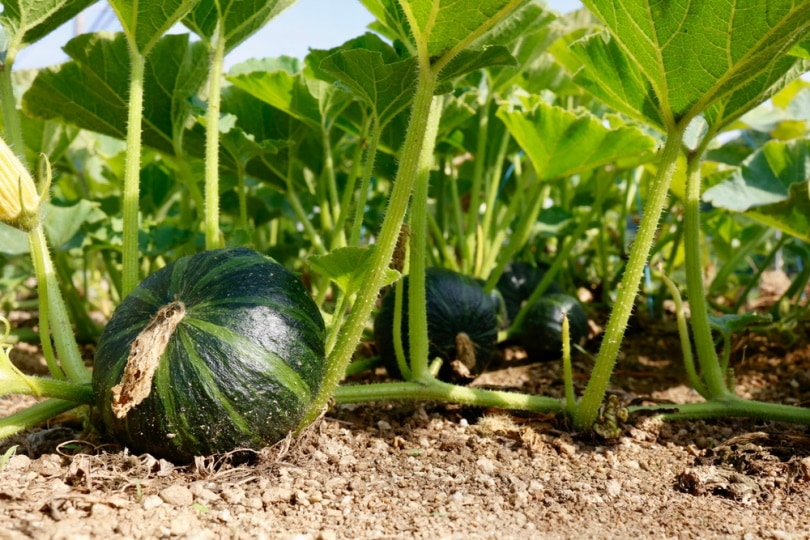
| Botanical Name | Cucurbita |
| Soil | Well-drained, sandy, fertile (pH 6.0–6.5) |
| Sun | Full sunlight |
| Hardiness Zone | 3–10 |
| Days to harvest | 40–120 days from planting |
| Average vine length | 6–20 feet |
The one thing that sets squash apart from other vegetables is that it’s very “aggressive” and takes up all the space in the garden. That’s why a trellis is a must. Besides, for squash, proper air circulation is critical. More importantly, by helping it grow vertically, you’ll keep all the animals, pests, and diseases at bay. Both winter and summer squashes are prolific and easy to train on a trellis.
The structure has to be strong, of course, like vinyl, metal, or even iron. Otherwise, it will break before you can do anything about that! Winter squashes are especially heavy and can reach 20 feet in length. Gently place the vines on the trellis, and the tendrils will wrap around it.
6. Large Pumpkins

| Botanical Name | Cucurbita maxima |
| Soil | Well-drained, organically rich (pH 6.0–6.8) |
| Sun | Full sunlight/partial shade |
| Hardiness Zone | 3–9 |
| Days to harvest | 90–130 days from planting |
| Average vine length | 10–20 feet |
Pumpkins belong to the squash family, and in many ways, they behave similarly. However, they are bigger, heavier, and can grow in partial shade. So, you can either pick a smaller variety or build a big and strong trellis. Much like squash, pumpkins gain from growing vertically instead of horizontally. And, again, thanks to the tendrils, they latch on easily. Autumn Gold and Fortuna White are our favorite species.
7. Watermelons
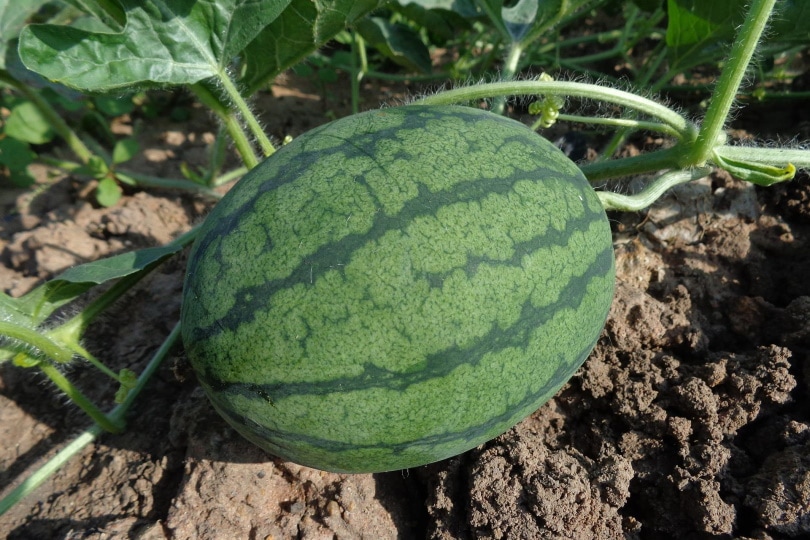
| Botanical Name | Citrullus lanatus |
| Soil | Well-drained, sandy, loamy (pH 6.0–7.5) |
| Sun | Full sunlight |
| Hardiness Zone | 3–11 |
| Days to harvest | 65–90 days from planting |
| Average vine length | 6–8 feet |
Who doesn’t like watermelons, right? They’re super sweet and look cool. With that said, they are the heaviest plants on the list and require lots of space to grow (10–20 square feet per plant). Furthermore, by default, watermelons grow horizontally, which means some training will be involved.
But, as long as the trellis is strong, the benefits will be worth it. These include more sun, air, and a bountiful harvest. You’ll get to enjoy the lovely taste in 2 months. Now, you can go with melons instead of watermelons, of course. However, they’ll be a bit harder to grow because melons aren’t as resistant to disease and pests.
8. Pole Beans
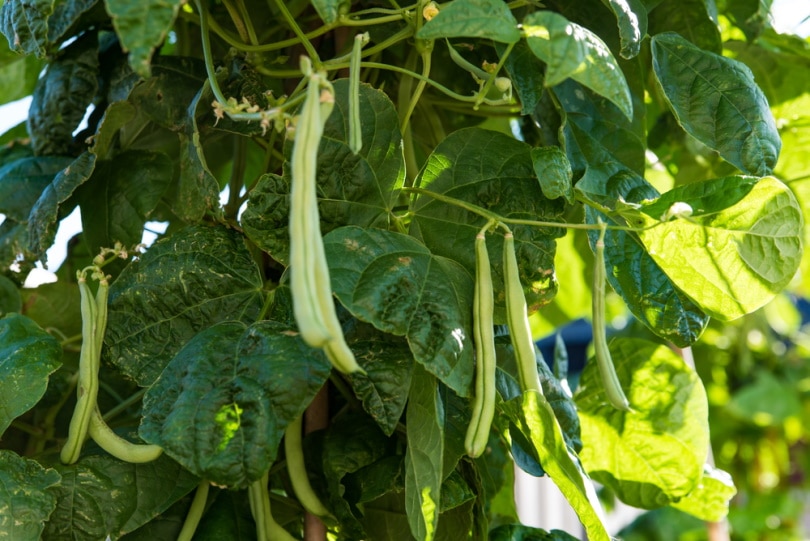
| Botanical Name | Phaseolus vulgaris |
| Soil | Well-drained, organically rich (pH 6.5–7.0) |
| Sun | Full sunlight/partial shade |
| Hardiness Zone | 9–11 |
| Days to harvest | 60–75 days from planting |
| Average vine length | 10–20 feet |
Alright, let’s switch from big and heavy to small and lightweight. Do pole beans really need a trellis? The answer is yes, they do. They are great at climbing and will get to the very top without any help. We recommend planting pole beans in organically-rich, well-drained soil. They grow best in full sunlight and tolerate partial shade but won’t survive in a harsh climate (below 25–30 degrees F).
In contrast to bush beans, pole beans reach up to 20 feet in length—another good reason to use a trellis. Tie them up, and that’s it!
9. Asparagus Beans

| Botanical Name | Vigna unguiculata |
| Soil | Well-drained, loose, sandy (pH 6.0–7.5) |
| Sun | Full sunlight |
| Hardiness Zone | 10–11 |
| Days to harvest | 65–80 days from planting |
| Average vine length | 6–10 feet |
Not a big fan of regular beans? Then what about the famous Asparagus beans? Also known as the yard-long beans, they are much shorter (6–10 feet), take a bit longer to grow (up to 80 days), and only thrive in full sunlight. Other than that, they’re not that different. Thanks to the below-average weight, even the simplest, least durable trellis will easily hold this vegetable.
10. Malabar Spinach
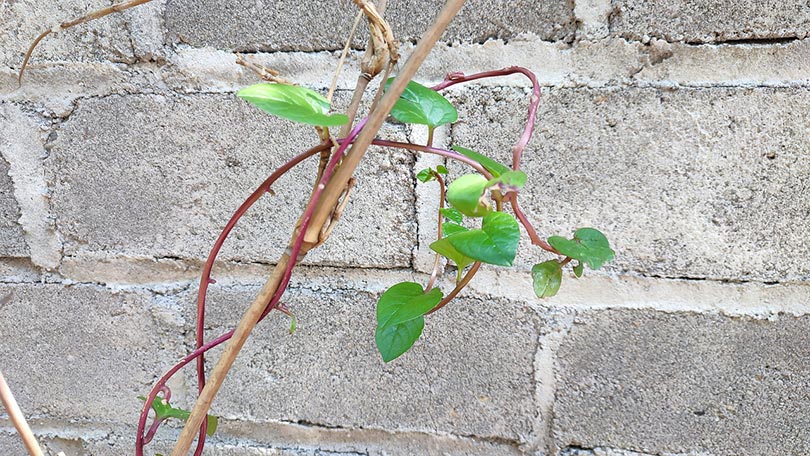
| Botanical Name | Basella alba |
| Soil | Well-drained, sandy, fertilized (pH 6.5–6.8) |
| Sun | Full sunlight/partial shade |
| Hardiness Zone | 7–11 |
| Days to harvest | 50–85 days from planting |
| Average vine length | 6–30 feet |
Heat-resistant and fast to grow (you can harvest it in 50 days), this tropical plant requires little maintenance. Plus, it “sticks” to a trellis quickly instead of sprawling on the ground and ruining the view. Now, while the average vine length is 6–12 feet, it can reach up to 30 feet! The Malabar spinach grows in partial shade but flourishes in hot and humid conditions and full exposure to the sun.
11. Sweet Potatoes

| Botanical Name | Ipomoea batatas |
| Soil | Well-drained, loamy, nutrient-rich (pH 5.0–7.5) |
| Sun | Full sunlight |
| Hardiness Zone | 9–12 |
| Days to harvest | 90–120 days from planting |
| Average vine length | 6–20 feet |
Sweet potatoes like to spread all over the yard (up to 20 feet in vine length), but if you train them to grow on a trellis, that will save lots of precious space. The plant does require some help at first because it’s more of a crawler, not a climber. These potatoes are hardy to zones 9–12 and don’t survive through the cold (below 70 degrees F). To try them out, you’ll have to wait for 3–4 months.
12. Jicama

| Botanical Name | Pachyrhizus erosus |
| Soil | Well-drained, sandy, (pH 7.0–7.5) |
| Sun | Full sunlight |
| Hardiness Zone | 10–12 |
| Days to harvest | 150–160 days from planting |
| Average vine length | 15–20 feet |
This is the last stop for us today. Jicama takes quite a long time to produce fruit. It’s not at all suited for colder climates and needs full sunlight to flourish. So, why would you want to grow it on a trellis? Well, if it’s tall and strong enough, jicama will get more sun, fewer diseases, and more space to thrive on its own. Space the plants at least 10–12 inches apart and watch them take over the trellis!
How to Choose the Right Trellis?
Trellises come in various shapes and sizes. At the core, they’re the same, but there are still some differences that set them apart. If you want to take your gardening to the next level, pick a trellis that’s best suited for every single vegetable in your garden. Here’s a quick look at the available options:
- Stakes. This is the cheapest, easiest to build, and most mobile trellis out there. Pick between metal, wood, or bamboo.
- A-Frame. It can be entirely made of wood or a wood + wire mesh combo. Perfect for heavy veggies like squash or watermelons.
- Teepee. Crafted from bamboo (an extremely flexible and resistant material), this trellis works great with smaller-than-average vines like beans and peas.
- Flat/Fence-Type. A good choice if you have limited space in the garden. Easy to pick crops from both sides and can support a squash or melon plant.
- Cages. Do a decent job of supporting plants with heavier-than-average veggies.
- Clothesline. Got some tall plants in your garden? The clothesline trellis will help you ensure further growth.
- Arch. A bit hard to build but allows walking underneath the vegetables. Rather sturdy and reliable; looks great.
Also, make sure the trellis is sturdy enough to withstand harsh nature. We’re talking about hail, winds, and storms. The size also matters (and it will differ depending on the plants), along with aesthetics. As for the soil, add compost every 6–12 months and keep weeds at bay.

Are Garden Trellises Expensive?
It all depends on what you’re looking for. For example, a 6-foot metal trellis will only cost $300-350. An 8-foot vinyl trellis, in turn, will set you back $700–$950. On average, gardeners in the US pay $750–$800 or $200 per linear foot, while a premium-quality option can be as expensive as $2,000. Steel is the cheapest material; then we’ve got iron, metal, plastic, composite, PVC, vinyl, and wood.
The price range goes from $350 to $1,100. The design affects the price as well. A cone-shaped trellis won’t cost much: $150–$230. In contrast, arches are quite pricey. Contractors don’t charge a lot for the installation, though. The labor cost only makes up $25 of the total cost. So, even if you’re on a tight budget, it will be best to have a professional handle the installation/mounting.
Conclusion
A trellis is a rather simple structure. Essentially, it’s a frame of latticework that supports climbing plants. However, it’s one of the most important additions to any modern-day garden. Even if you only have one or two vining vegetables growing in your backyard, a trellis is still a must-have. Today, we checked out 12 plants that will make every single penny (and hours of work) count.
They will grow faster, produce more veggies, and be stronger against diseases and pests. More importantly, you’ll get to maximize your space and get the most out of it. So, pick a plant you like, install a trellis, and watch your garden turn into a vertical masterpiece!
- Wayfair – What Is a Trellis?
- Trellises and cages to support garden vegetables
- How Much Does It Cost to Install a Trellis?
- How Much Does It Cost To Build A Trellis?
- 10 AWESOME VEGETABLES THAT CAN BE TRELLISED
- 10 Best Vegetables to Grow on a Trellis for Vertical Gardening
- Vertical Gardening: 10 Vegetables that Love to Climb
- Vegetables That Work Best for Vertical Gardening
- 12 Climbing Vegetables that will Thrive when Trained up Garden Walls
Featured Image Credit: Trong Nguyen, Shutterstock
Contents


